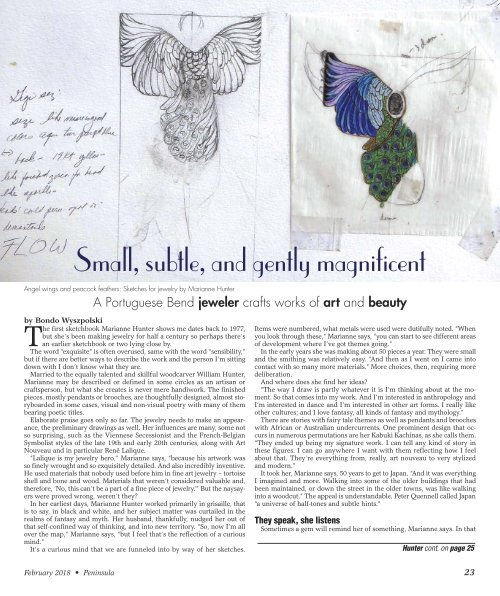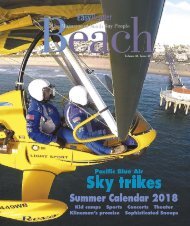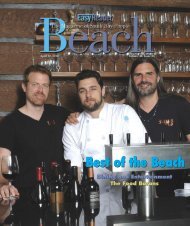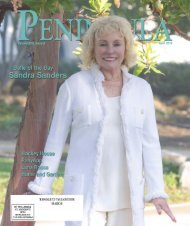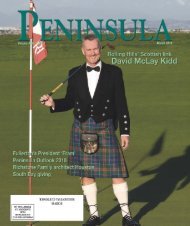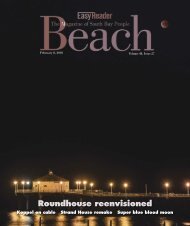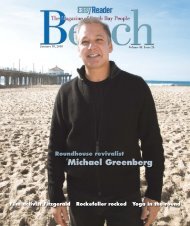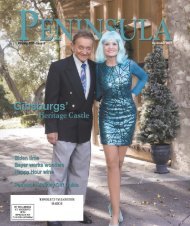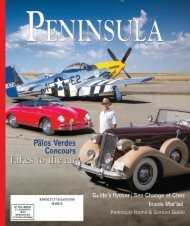Peninsula People Feb 2018
You also want an ePaper? Increase the reach of your titles
YUMPU automatically turns print PDFs into web optimized ePapers that Google loves.
Small, subtle, and gently magnificent<br />
Angel wings and peacock feathers: Sketches for jewelry by Marianne Hunter<br />
A Portuguese Bend jeweler crafts works of art and beauty<br />
by Bondo Wyszpolski<br />
The first sketchbook Marianne Hunter shows me dates back to 1977,<br />
but she’s been making jewelry for half a century so perhaps there’s<br />
an earlier sketchbook or two lying close by.<br />
The word “exquisite” is often overused, same with the word “sensibility,”<br />
but if there are better ways to describe the work and the person I’m sitting<br />
down with I don’t know what they are.<br />
Married to the equally talented and skillful woodcarver William Hunter,<br />
Marianne may be described or defined in some circles as an artisan or<br />
craftsperson, but what she creates is never mere handiwork. The finished<br />
pieces, mostly pendants or brooches, are thoughtfully designed, almost storyboarded<br />
in some cases, visual and non-visual poetry with many of them<br />
bearing poetic titles.<br />
Elaborate praise goes only so far. The jewelry needs to make an appearance,<br />
the preliminary drawings as well. Her influences are many, some not<br />
so surprising, such as the Viennese Secessionist and the French-Belgian<br />
Symbolist styles of the late 19th and early 20th centuries, along with Art<br />
Nouveau and in particular René Lalique.<br />
“Lalique is my jewelry hero,” Marianne says, “because his artwork was<br />
so finely wrought and so exquisitely detailed. And also incredibly inventive.<br />
He used materials that nobody used before him in fine art jewelry – tortoise<br />
shell and bone and wood. Materials that weren’t considered valuable and,<br />
therefore, ‘No, this can’t be a part of a fine piece of jewelry.’” But the naysayers<br />
were proved wrong, weren’t they?<br />
In her earliest days, Marianne Hunter worked primarily in grisaille, that<br />
is to say, in black and white, and her subject matter was curtailed in the<br />
realms of fantasy and myth. Her husband, thankfully, nudged her out of<br />
that self-confined way of thinking, and into new territory. “So, now I’m all<br />
over the map,” Marianne says, “but I feel that’s the reflection of a curious<br />
mind.”<br />
It’s a curious mind that we are funneled into by way of her sketches.<br />
Items were numbered, what metals were used were dutifully noted. “When<br />
you look through these,” Marianne says, “you can start to see different areas<br />
of development where I’ve got themes going.”<br />
In the early years she was making about 50 pieces a year. They were small<br />
and the smithing was relatively easy. “And then as I went on I came into<br />
contact with so many more materials.” More choices, then, requiring more<br />
deliberation.<br />
And where does she find her ideas?<br />
“The way I draw is partly whatever it is I’m thinking about at the moment.<br />
So that comes into my work. And I’m interested in anthropology and<br />
I’m interested in dance and I’m interested in other art forms. I really like<br />
other cultures; and I love fantasy, all kinds of fantasy and mythology.”<br />
There are stories with fairy tale themes as well as pendants and brooches<br />
with African or Australian undercurrents. One prominent design that occurs<br />
in numerous permutations are her Kabuki Kachinas, as she calls them.<br />
“They ended up being my signature work. I can tell any kind of story in<br />
these figures. I can go anywhere I want with them reflecting how I feel<br />
about that. They’re everything from, really, art nouveau to very stylized<br />
and modern.”<br />
It took her, Marianne says, 50 years to get to Japan. “And it was everything<br />
I imagined and more. Walking into some of the older buildings that had<br />
been maintained, or down the street in the older towns, was like walking<br />
into a woodcut.” The appeal is understandable. Peter Quennell called Japan<br />
“a universe of half-tones and subtle hints.”<br />
They speak, she listens<br />
Sometimes a gem will remind her of something, Marianne says. In that<br />
Hunter cont. on page 25<br />
<strong>Feb</strong>ruary <strong>2018</strong> • <strong>Peninsula</strong> 23


